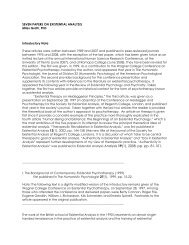The Sonate auf Concertenart: A Postmodern Invention? David ...
The Sonate auf Concertenart: A Postmodern Invention? David ...
The Sonate auf Concertenart: A Postmodern Invention? David ...
Create successful ePaper yourself
Turn your PDF publications into a flip-book with our unique Google optimized e-Paper software.
<strong>Sonate</strong> <strong>auf</strong> <strong>Concertenart</strong>, p. 19<br />
55<br />
the use of what Steven Zohn describes as "gestures associated with the concerto." Among the<br />
latter are homophonic or unison textures, a filler viola part, instrumental recitative, "aria-like slow<br />
movements," and a type of binary-form final movement characterized by athletic passagework,<br />
often with imitation or voice-exchange between the upper parts. Each of these deserves<br />
consideration, bearing in mind that earlier musicians did not necessarily share modern perceptions<br />
of the "markers" that characterized instrumental concertos or concerto style.<br />
<strong>The</strong> most important of these has certainly been ritornello form. What, in fact, is meant by<br />
"ritornello form" (or "Vivaldian" ritornello form) in modern writings? Minimally, it appears to be<br />
almost any material heard at the outset of a piece and repeated later, such as the brief opening<br />
phrase played by the tutti at the outset of Vivaldi's G-minor concerto for flute, oboe, violin,<br />
56<br />
bassoon, and continuo, RV 107. Russell Stinson even speaks of the one-measure fugal subject of<br />
the organ chorale Herr Jesu Christ, dich zu uns wend, BWV 655 as "a ritornello," and Jean-<br />
Claude Zehnder has described equally short passages as Kurz-Ritornellen in instrumental works<br />
by Torelli and others that Bach might have encountered during the first decade of the eighteenth<br />
century. 57<br />
<strong>The</strong> word ritornello (or its cognates) appears frequently in performing materials from the<br />
first two decades of the century, but often attached to instrumental refrains in vocal movements<br />
58<br />
whose style and form recall the old strophic aria. <strong>The</strong>se ritornellos rarely modulate and rarely<br />
55<br />
Zohn, "<strong>The</strong> Ensemble Sonatas," 491-2. At issue is whether ritornello form,<br />
"stereotypical orchestral gestures," and other markers indeed constitute "generic reference to the<br />
concerto allegro," as Zohn suggests in "<strong>The</strong> <strong>Sonate</strong> <strong>auf</strong> <strong>Concertenart</strong> and Conceptions of Genre."<br />
56<br />
Cited by Swack, "On the Origins,"375. Very brief ritornellos can be found in early<br />
eighteenth-century arias, e.g., the three-measure ritornello of the soprano aria "Ich traue Gott"<br />
inTelemann's Gelobet sey der Herr, TWV 1:596 of 1719 (examined in the copy from the Grimma<br />
collection in Dresden, Sächsische Landesbibliothek [Dl], Mus. ms. 2392-E-591). But these are<br />
somewhat unusual, and passages actually labeled as ritornellos (see below) are usually somewhat<br />
longer.<br />
57<br />
Russell Stinson, J. S. Bach's Great Eighteen Organ Chorales (New York: Oxford<br />
University Press, 2001), 21; Jean-Claude Zehnder, "Giuseppe Torelli und Johann Sebastian Bach:<br />
Zu Bachs Weimarer Konzertform," Bach-Jahrbuch 77 (1991): 35. <strong>The</strong> first section of BWV 655<br />
(mm. 1-51), which both writers describe in terms of a concerto, could be viewed with equal<br />
justice as an invention or sinfonia.<br />
58<br />
As in the "Ritournello" that precedes the soprano solo "Ein Mensch" in Telemann's early<br />
Trauer-Actus TWV 1:38, Ach wie nichtig (seen in the sole source, Dl Mus. ms. 2392-E-551).<br />
Although unrelated to the soprano solo except by key and meter, the passage is apparently to be<br />
repeated afterwards. Heinichen's early German cantatas incorporate similar forms, as in Es<br />
naheten aber zu Jesu (preserved in Dl Mus. ms. 2398-E-502), in which da-capo (or quasi dacapo)<br />
arias for tenor and bass stand alongside strophic lieder for soprano and alto. In the<br />
autograph score of Cantata 68, Bach placed the word Ritornello, apparently in the older sense of















